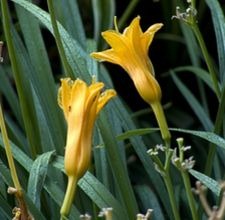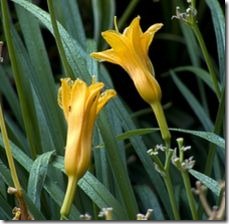Daylilies fill perennial borders from Florida to Minnesota and back to southern California because of their easy care and ability to adapt. Like true lilies, they bloom in a glorious burst from spring through summer, depending on the variety, then spend the rest of the year gathering nutrients for bloom the following year. Their winter habits depend on where they grow.
Dormants and Evergreens
-
Early daylily hybrids grew in the Brooklyn Botanical Garden, creations of A.B. Stout, who collected his species plants from their native China and Japan. Plants called "dormants" grew, bloomed and then died back like other herbaceous perennials. Subsequent hybridizers and hobbyists developed plants suited togardens further south. They bloomed in summer but also maintained a mound of foliage through most of the winter months. These plants were dubbed "evergreen." Some evergreen hybrids grow in areas where winter temperatures dip below freezing as "semi-evergreens" that die back only when the ground freezes, a date that varies by hardiness zone. Not all evergreen daylilies survive the cold of the north.
Pruning
-
Even evergreen daylilies stop blooming by fall and non-seed bearing scapes, the stems that support flowers, turn brown and can be removed. New leaves grow on daylilies from the inside of the leaves atop the crown called a fan. Outside leaves turn brown or discolor and can be removed as they fade. Weekly cleanup continues on evergreen daylilies until spring. Large clumps of dormants benefit from trimming to about 6 inches tall, in areas where rodents or rabbits look for winter shelter. In many areas, dormant daylily pruning can be left until spring.
Chilling
-
All daylilies, even evergreen varieties, need a rest. Dormants rest for months during which the winter chill encourages propagation of new buds within the previous year’s crowns. Dormant daylilies vary in their need for chilling, but the result of an insufficient chilling period is lack of bloom the following summer. The plant may or may not weaken, but it will not produce blooms. The chilling requirement helps explain why cultivars are hardy only over three or four growing zones, even though daylilies as a species are hardy over all U.S. zones from the Canadian border to the Gulf of Mexico.
Mulching
-
Winter mulch protects roots from drying winds and wide temperature swings. Mulch should never snug up around the daylily crown where it can trap moisture and encourage fungus and virus proliferation. Most daylilies benefit from 2 to 6 inches of fresh winter mulch consisting of straw, hay or hardwood tree leaves. In areas where daylilies are fully hardy or enjoy shelter by evergreen shrubs and trees, less mulch need be added. Daylilies resume active growth in late winter or very early spring; light summer mulch replaces winter mulch to control weeds and keep roots cool until the leaves fill out.


Deprecated: strpos(): Passing null to parameter #1 ($haystack) of type string is deprecated in /home/agriviek8Qv/agriviet.net/public_html/wp-includes/comment-template.php on line 2522